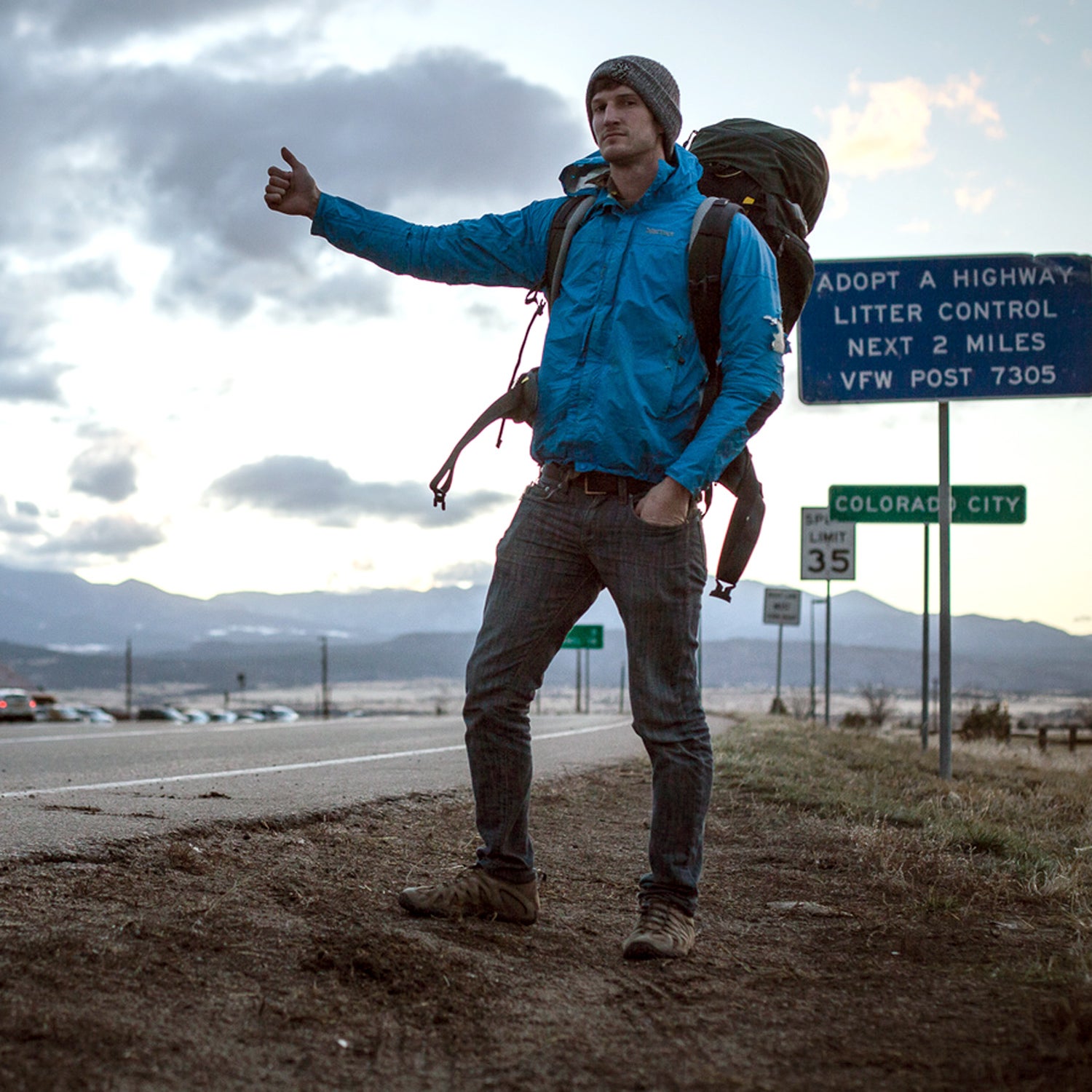It was less than 20 degrees in Nashville, Tennessee, when Matt Cairns stood in the shoulder of Interstate 440 westbound with his arm outstretched and his thumb in the air. It was February, and a rare bout of severe cold weather was slamming the American South. Cairns wore four layers, thick gloves, and a wool hat.
Tall, lean, and clean-shaven, the 25-year-old did not fit the stereotypical image of the hitchhiker—dirty, derelict, and desperate. With his tousled hair sticking out from underneath his puffy cap, he looked instead like an all-American boy.
Blame it on being an extrovert, a middle child, or growing up in a conservative household, but Cairns has always possessed an unquenchable urge to travel and meet strangers. He has already visited five continents, and none of his trips have involved a beach chair and a good novel. The ideal getaway spans at least one month, more nights sleeping outdoors than indoors, and going far off the grid. He’s motorcycled from Chile to Colombia. He’s canoed his way from Winnipeg to Churchill in Manitoba, Canada. But his most preferred mode of transportation is hitchhiking.��
Armed with an 80-liter camping backpack and a Canon 6D camera, the didn’t have to wait long before Sam, a friendly healthcare worker, pulled over to pick him up. Sam was running some local errands and only able to take Cairns two exits west, but when you’re hitchhiking in sub-freezing temperatures, no ride is ever too short.��
Concrete statistics on hitchhiking are hard to find and verify; what’s clear is that while hitchhiking was once a convenient, cost-free, and somewhat common practice, its popularity has declined rapidly, especially in the U.S., since the 1970s. There are a few reasons for this.��
For one, public transportation has become more expansive and relatively cheaper. Air travel, once the most expensive mode of transportation, has become more affordable thanks in large part to the Airline Deregulation Act in 1978, which made it so ticket prices were no longer regulated by the government. The rate of car ownership has skyrocketed, too. According to data collected by the Bureau of Transportation, there were approximately 61 million cars owned by Americans in 1960, good for one car for every three people. In 2008, this number rose to over 137 million cars, or a little less than one car for every two people.��
Serial killers such as Edmund Kemper and Dean Corll made headlines after targeting hitchhikers in the 1970s.
The most obvious reason for the demise of hitchhiking, though, is the stigma attached to it. Most often, it was hitchhikers themselves who were considered to be in danger.��As Ginger Strand writes in her book , “hitchhiker murders were publicized throughout the seventies.” Serial killers such as Edmund Kemper and Dean Corll made headlines after targeting hitchhikers in the 1970s.��Charles Manson and his followers were also rumored to have killed a number of hitchhikers after Manson went on trial in 1970.��Around this time, the Federal Bureau of Investigation was running campaigns .��Some cops even began taking in young female hitchhikers “for their own safety.”
Cairns doesn’t consider himself a spokesperson for hitchhiking, but he does “want to give hitchhiking a good name.” At the same time, he’s aware of the risks that he faces as a hitchhiker stepping into a stranger’s vehicle. Cairns, a natural conversationalist and perpetual optimist, made a point of telling me that he never felt threatened on any of the over 50 rides he accepted on this trip. But there were times he was uncomfortable. One time, for instance, he found himself riding with a driver who was clearly under the influence of some substance. There was no confrontation, but Cairns did ask to be let out early from that vehicle.��
Just outside of Memphis in February, a Utah-based trucker named Dustin picked up Cairns and ended up taking him over 1,000 miles west to Denver.��
Cairns can only describe Dustin as “one of the nicest people I’ve ever met.” During their two-night trip through Arkansas, Oklahoma, Kansas, and Colorado, Dustin played DJ and switched back and forth between 80s hair metal and Mormon books-on-tape. While sipping a can of San Pellegrino, which he always kept stocked in a cooler while on the road, he told Cairns that he was raised, and still is, a devout Mormon. He subsequently feels guilty when he indulges in some of his favorite hobbies, like karaoke—which of course they did together on their last night, at a dive bar outside of Denver.��
Cairns ran into lots of other unique people on his transcontinental journey (he on his webpage for the project). There was an ex-gang member, his arms covered in tattoos, who changed his life to become a family man. An 18-year-old girl who left her home in Michigan to search for her true purpose in life. A homeless, schizophrenic man with only one good eye—his name was Chad, and with his deformed right eye, dirty fingernails, and a gnarly beard, even Cairns admits that he “had an initial fear of him.” But he felt ashamed of this when he offered Chad a razor and shaving cream so that he could neaten up, and Chad attempted to pay him back for the gesture.
When a young Egyptian immigrant dropped him off in front of his apartment, he had spent 15 nights on the road, accepted somewhere between 50 and 60 rides from strangers, and met more than 100 people, most of whom he will almost certainly never see again. They’d all come from very different walks of life, and they’d all been kind to him. It seems that some people just like a man who gives them a “thumbs up.”
Matt Cairns is a photojournalist based in Arizona. .��


